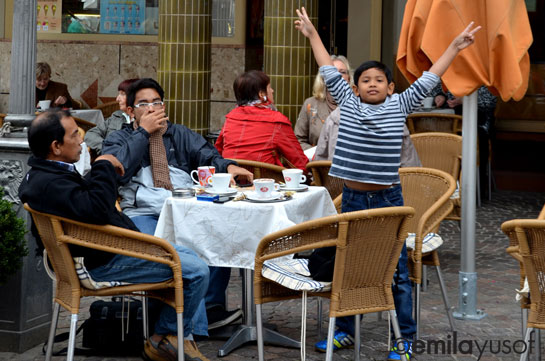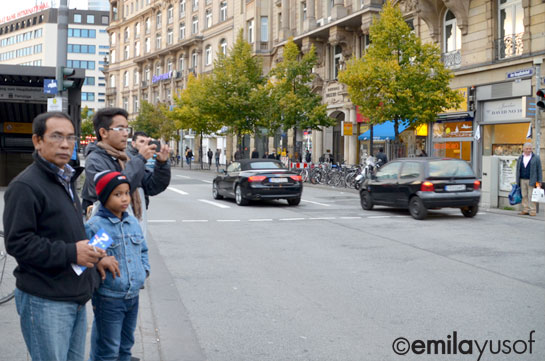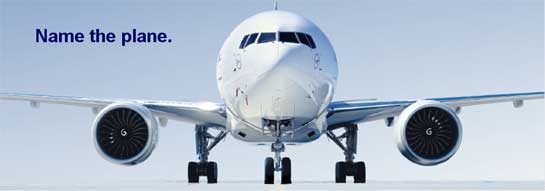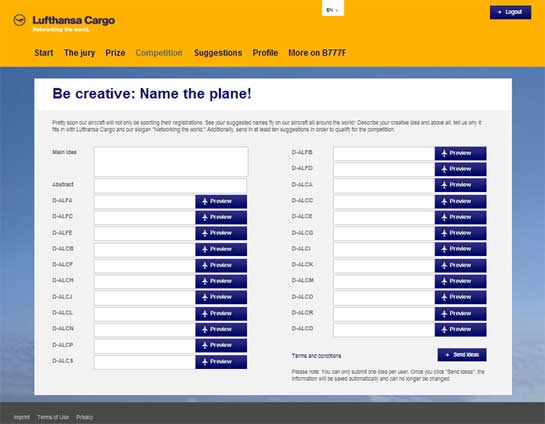Germany
-
I’m back from Frankfurt!
Oh I miss my blog! I tried to update my blog from Frankfurt but didn’t have enough time to do so. Frankfurt was great! I had 3 days to spent with my family and they rest were spent at book fair. I missed the zoo and Main Tower as I had to be at the fair. But my family did had a great time there.
I will blog about places in Frankfurt individually but at the meantime, here are some photos from our trip:
 Me reaching up for autumn leaves.
Me reaching up for autumn leaves.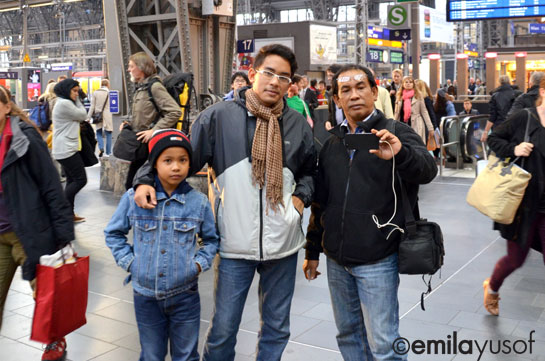 Yassin, Azmi (my stepson) and my husband.
Yassin, Azmi (my stepson) and my husband. Yassin and Azmi in front of Hauptwache old police station, now converted to restaurant.
Yassin and Azmi in front of Hauptwache old police station, now converted to restaurant.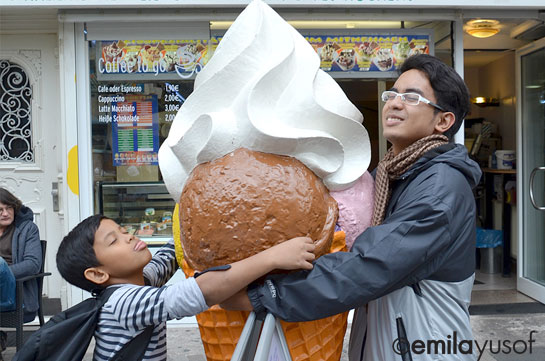 Yassin and Azmi hugging giant ice-cream.
Yassin and Azmi hugging giant ice-cream. -
Lufthansa’s Name The Plane contest!
Lufthansa will be welcoming their first Boeing 777F in Frankfurt in October. They are really looking forward to it, but there is still one thing missing: the name of the aircraft.
So, Lufthansa is inviting YOU to help them find a name for their fleet!
Put on your thinking cap and get creative. Go to the contest page, register and submit the names that you have thought of by July 15. Let there be no boundaries to your creativity.
Their top-class jury will choose A NAME from the entries at the end of the brainstorming phase.
The winner will get to be there when they welcome their first Boeing 777F in Frankfurt! This will include a Lufthansa flight and an overnight stay in Frankfurt. And that is not all: you could be one of the first to join Captain Claus Richter on the flight deck!
Think of at least 10 names and then go to the NAME THE PLANE website. By default it’s in Deutch, click on English, ok. And proceed from there. Good luck!
-
Art & Places: Madonna at Kornmarkt, Heidelberg, Germany
“Every block of stone has a statue inside it and it is the task of the sculptor to discover it.” ~Michelangelo.

In the case of the beautiful baroque statue above, it was sculpted by Peter von den Branden in 1718.
Known as Madonna of the Corn Market (Kornmart in German language), this statue still stands proudly in the Kornmarkt, where she is appreciated not only for her religious meaning, but her artistic as well.
As Mary (Maria) became the patron saint of Catholic belief in the Palatinate, this statue was built by the Jesuits for The Prince Elector, who was trying to persuade the people of Heidelberg to switch to Catholicism. He failed as many of the Protestants preferred to migrate out of Heidelberg.
Mary demonstrates three typical characteristics of this period: Queen of Heaven, a virgin and Lady of Victory. She stands with her baby (Jesus) in hand on a gilded round cloud formation supported by four cherubs. The baby has his right hand raised in a blessing gesture wile his left hand holding a spear in the head of the snake dragon which represents the Protestants.
The statue stands on a pedestal base (7.38m high) equipped with three fountains bowls and was created in red sandstone. Other materials include various metals such as copper, brass and iron.
Information source:
Tourism Heidelberg – Madonna of the Corn Market
Wikipedia – Madonna Kornmarkt
Databank – Konrmarkt Madonna -
Altstadt, Heidelberg
I believe I haven’t share my experience visiting the Altstadt (Old Town), Heidelberg, Germany. Make yourself a coffee while reading this post with many interesting photos I captured for you.
 Altstadt.
Altstadt.Altstadt, the oldest part of Heidelberg, sits just below the Schloss. It extends along the Neckar River for a mile, with Karlstor on one end, and Bismarckplatz on the other.
 Neckar River on the left, Altstadt on the right.
Neckar River on the left, Altstadt on the right.Altstadt is a wonderful combination of old and new buildings, narrow streets, market squares, arts, history, science, shopping, eating and relaxing.


The Hauptstraße is the main road through the Altstadt, and is where most of the shopping is located. It is Europe’s longest car free zone (1.6km).
Other points of interest that can be found in the Altstadt include the Kornmarkt, the Church of the Holy Spirit, Hotel Zum Ritter and the Old Bridge.
Above is the Kornmarkt (Corn Market) which was once used for the collection and trade of agricultural goods. Seen at the background is the Town Hall (Rathaus). Rathaus was built first in 1701 after the War of the Palatinate Succession. In 1751 Prince Elector Karl Theodor embellished the building, and then in 1886, the east building was added. In 1908, part of the Town Hall was destroyed by a fire, and so once more had to be rebuilt. The building was expanded in 1961, adding another wing as well the bell tower.
 Church of the Holy Spirit (Ghost).
Church of the Holy Spirit (Ghost).One of the few buildings in Heidelberg to survive the many wars during the past centuries is the Church of the Holy Spirit which stands reverently in the Marktplatz. The construction of the church was completed in 1544 since the the foundation was laid in 1398. The church has been home to Catholics and Protestants alike throughout the centuries. In 1706 a divider separating the two denominations was put in when both wanted to have services there, and it remained until the 1930’s. The church also has remains of the tombs and epitaphs of the Palatinate electors as well as a collection of manuscripts.
 Hotel Zum Ritter.
Hotel Zum Ritter.Hotel ZumRitter is located directly opposite the Church of the Holy Spirit on the Hauptstrasse. It was built in 1592, and is one of the very few buildings in Heidelberg to have survived the War of the Palatinate Succession. It is considered to be one of the most remarkable examples of the late German Renaissance period.

Prince Elector Carl Theodor built the Old Bridge in 1786. Although the fifth bridge built over the Neckar in this location, it was the first stone bridge to be constructed. The twin towers on the city side of the river were once part of the city wall, and contain dungeons used for housing criminals. In the center of these, hanging above the portcullis, is a plaque giving acknowledgement to Austrian troops who helped defend the bridge against a French attack in 1799. One of the most notable items on the bridge is the statue of a monkey holding a mirror. The legend surrounding this curious statue tells us that it symbolizes the fact that neither the city-dwellers nor the people who lived outside the city were better than the other, and that they should look over their shoulder as they cross the bridge to remember this.
I hope you enjoy reading this. I have hundreds of photos captured here and I will post more when time permits.
Information source: Tourism Heidelberg
-
Moleskine: sketches of botanical plants at PalmenGarten
I just got around to sketch some simple botanical drawings on my Moleskine sketchbook.

Pen and watercolor on Moleskine sketchbook. -
A walk in the PalmenGarten, Frankfurt
As a nature lover, I will try my best to not miss visiting gardens when I travel. And so during the Frankfurt city tour (sponsored by Sedunia Travel), I asked the tour guide to drop me at PalmenGarten. The bus stopped at Bockenheimer Landstrase and I had to walk a bit and turn to the first right lane before I saw the entrance. Paid 5 Euros to enter the garden.

Built in 1869, Palmengarten features some very different themed gardens and can be visited at anytime of the year. With the motto “Plants, Life, Culture”, Palmengarten points to its function for the community as an educational, social, and cultural institution in the center of Frankfurt.
A haven for plants from all around the world, Palmengarten displays a collections of more than 13,000 subtropical and tropical species. With the recent merging of the Botanical Garden of the University of Frankfurt and the Palmengarten, the collection now has expanded to 18,000 plant species.
From the entrance at Bockenheimer Landstrasse, I started to walk to the left side passing by Gesellschaftshaus.

Opposite to the side of Gesellschaftshaus, there were two small ponds where ducks and geese swam gracefully.

And here are some more photos on my way further up.

A couple enjoying their walk.
Administration building.Opposite the Administration building, there’s an appealing, geometrically landscaped Rose Garden with a pavilion; Haus Rosenbrunn as the centerpiece. The borders teem with scented roses and rare traditional varieties along with other unique plants.

Next, I walked to the Tropicarium where the plants here are divided into groups according to their natural habitats. The Tropicarium is composed of seven large greenhouse units. The southern group of greenhouses is devoted to plants from the arid tropics, namely semi-desert regions, fog desert, deciduous dry forests, and thorn forests. The northern complex for the humid tropics features plants from monsoon forests, cloud forests, mangrove swamps, and lowland rainforests. Temperature and humidity here are computer controlled.

Further up, there is Goethe Garden. During the 17th and 18th centuries, it had become customary that well-to-do citizens acquired parcels of land outskirts of the city forthe purpose of culrivating and maintaining vineyards, orchards and vegetable gardens and this also included the well-known Goethe family. Johan Caspar Goether bought a plot of land where he and his son Wolfgang planted apple trees. Several sources of literature led to believe that the apple orchard represented a part of Palmengarten.

Across from the Goethe Garden, there’s open area presents mainly herbaceous perennials and annual plants from the grassland steppes of Asia and Europe and prairies of North America. The low nutrient supply and rapid soil drainage are ideal conditions for these plants. The adjoining meadow, which is mowed twice a year, is home to a diverse array of rare grasses and meadow flowers which are seldom observed in nature anymore.

After walking around the Steppes area, I was quite hungry. There’s a food kiosk there and I had a coffee and banana muffin. These were my lunch.

Across where I sat, there’s Haus Leonhardsbrunn. Non-hardy cushion and mountain plants can be viewed from the outside of the two greenhouses flanking Haus Leonhardsbrunn. The greenhouses in between are devoted to non-hardy mountain plants mainly from the Southern Hemisphere. The flower beds in front of the building usually display varieties of dahlias. Adjoining them is a huge playground, a water playground, a kiosk, a miniature golf course, and the northern train station of the Palmen-Express.


My batteries for both cameras went weak after that and looking at the map, I was just half way done exploring. Ah well, maybe this is one of the reasons that I have to come back here to explore the other half. Anyway, here are few more photos before my cameras ran out of batteries.
 Log playhouse.
Log playhouse.
Ash tree (Fraxinus).
Coneflowers.
More trees and birds.Well, there are actually about 15 – 20 pictures more before the cameras really died on me. And yes, few hundreds of pictures earlier. I’ll share them on my Instagram account slowly, ok.
If you happen to visit Frankfurt, do visit Palmengarten. Here are some information about the place:
Opening hours:
Feb — Oct: 9 am — 6 pm
Nov — Jan; 9 am — 4 pmTickets:
Adults — 5 Euros
Children and Adolescents up to age 14 — 2 Euros
Groups( 20+ persons) — 4 Euros - Art & Places, Frankfurt, Germany, graphite, moleskine, prismacolor, sculpture, Travel illo, TRAVEL/HOLIDAYS
Art & Places: Statue of Minerva, Romerberg, Frankfurt
Here is a statue of Minerva situated in front of timbered houses at Romerberg, Frankfurt.

Pencil and color-pencil on Moleskine plain notebook.Minerva was an ancient Roman goddess of wisdom and reason, of warfare for a good cause, protector of handicrafts, arts, schools and sciences. She was the daughter of Jupiter, the king of the gods.
Minerva was built from red sandstone by sculptor Friedrich Schierholz in 1893/94. It was half destroyed in 1944 during the WW2 and again in 1951 by the Romans. Later in 1983, sculptor Fritz Klimsch sculpted an exact copy of the statue. Minerva wears a lion head’s helmet with a crest decorated with a head of a woman (not sure what this means) and feathers.
She holds a spear on her left hand while the head of Medusa on her right. She is wearing a toga protected with an Aegis, a shield or buckler, on her body. She stands on a column decorated with floral ornaments.

Reference:
Kunst Im Offenlichen – Minerva Fountain

